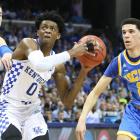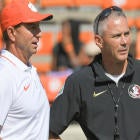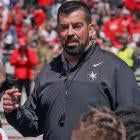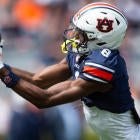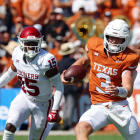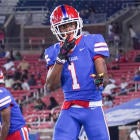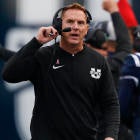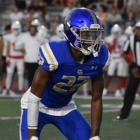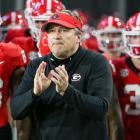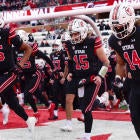LeBron James could play professional football if he wanted. Plenty of people want him to do it, too. He’s a one-percent-of-one-percent type of athlete.
But while James remains solely the king of the NBA, there are plenty of examples of two-sport athletes in football and basketball at the high school and college levels. It just becomes harder and harder to keep playing both as time goes on.
Still, such a fantasy didn’t stop us from wondering how some of college basketball’s biggest stars would do on the college gridiron once March Madness ended. After watching Kentucky’s backcourt tear apart opponents on both ends of the court in March, wouldn’t you want to see that speed and athleticism on display in the fall?
All of this requires us to suspend disbelief -- at least a little bit. Football is a sport that exists on contact and carries a different set of demands both physically and mentally. Transitions aren’t seemless. But if the following college basketball stars could play big-time college football, here’s where they’d end up.
Bam Adebayo, Kentucky forward
College football position: Defensive end
There are lengthy edge rushers like Myles Garrett. Then there are guys like Abedayo, who at 6-foot-10 and 260 pounds, would be an absolute force on the line as a freak athlete. Aedbayo wouldn’t have to sacrifice weight to reasonably play the position at a high level, which makes this transition extremely appealing.
Lonzo Ball, UCLA guard
College football position: Quarterback
It’s a little astonishing that so many people ragged on Ball after UCLA’s 86-75 loss to Kentucky in the Sweet 16. Some of it, you would think, is unfair backlash really meant for his father, LaVar Ball, who tends to do things like use his son’s name in the same sentence as Steph Curry’s. Granted, Ball wasn’t the best player on the floor in the Sweet 16 -- Kentucky guard De’Aaron Fox was -- and that’s largely because Ball wasn’t a factor shooting. But anyone who watched knows Ball delivered some pinpoint passes. The court vision he showed was NBA-level. There had to be a percentage of missed scoring opportunities/turnovers/etc. that UCLA accumulated simply because guys weren’t ready for a pass that only Ball could make.
So here’s where the football comparison applies. If Ball, with the anticipation and quick decision-making he possesses, could make those type of passes with a football, some college program would get a hell of a quarterback. At 6-foot-6, the freshman would have plenty of height to see the entire field with athleticism to boot. He’d have to pack on some weight to withstand the rigors of the game, but Ball has the makings of a field general.
Miles Bridges, Michigan State forward
College football position: Tight end
This was easy. The size, the athleticism -- it’s all there. The knock on Bridges as he mulls over his future is that he’s a true tweener lacking ideal size (6-foot-7, 230 pounds) as a power forward. The comparison to ex-Michigan State forward Draymond Green is made frequently, if for no other reason than it’s an easy one to make. However, that frame is perfect at tight end, and Bridges has the explosiveness and raw athleticism to be a mismatch at the second and third level of the defense. You can let him blow by linebackers or throw the ball up and let him come down with it.
Chris Chiozza, Florida point guard
College football position: Wide receiver, specialist
Chiozza has the speed and quickness to burn, which would make him a fun slot guy and return man in football. (And, hey, the Gators could use some offensive help.) His game-winning shot against Wisconsin in the Sweet 16 was spectacular given he was running at full speed and jumping off balance, but he also covered about 70 feet in three seconds. That’s straight-line speed perfect for kickoffs and punts.
Bonzie Colson, Notre Dame forward
College football position: Linebacker
Colson is probably too small to be a forward in the pros, but he checks out perfectly as a linebacker at 6-foot-5 and 225 pounds. He’s been a strong leader for the Irish and in the conversation for national player of the year by averaging a double-double. If you want a strong, seasoned leader on the defense who can get everyone in place, Colson is your man.
Mo Alie-Cox, VCU forward
College football position: Tight end/defensive end
No joke: Alie-Cox has received looks from NFL scouts. For a few years now, in fact. Two-sport athletes of the Julius Thomas mold -- meaning they are predominantly known for basketball over football -- aren’t mined frequently for the NFL, but they do exist. Alie-Cox has the size and athleticism to out-run other big men, meaning he’s be perfect at tight end. But his experience also lends him to an edge rusher spot. “I always played tight end and defensive end,” Alie-Cox told Hero Sports last December. “When I transferred to private school after my ninth grade year, they didn’t have football. I was pretty much forced to stick with basketball and ended up landing a DI scholarship.”
De’Aaron Fox, Kentucky guard
College football positionosition: Defensive back
There was a long, hard thought process about whether to put Fox at wide receiver or defensive back. It’s easy to fall in love with Fox’s length at either position. However, he’s shown tremendous defensive chops in the tournament and there’s a need these days for longer defensive backs to match up against big receiving targets. Put him in football’s center field and let him cover ground or up close to the line to go one-on-one with a big wideout. His versatility could be a huge asset.
Josh Jackson, Kansas forward
College football position: Wide receiver
I’ll keep this short and sweet. Get the dadgum ball to the 6-foot-8 guys screaming down the field on a go route. It’s fast break/transition points all day long, but on turf.
Przemek Karnowski, Gonzaga center
College football position: Offensive tackle
This is the hardest position to transition to from basketball. There’s a simple reason: The girth just isn’t there. Take a true center in basketball -- Creighton’s Justin Patton, for example -- and there’s still a difference in about 70 or 80 pounds needed to work in the trenches. That’s not an issue for Karnowski -- all 7-foot-1 and 300 pounds of him. But it’s not just size he has going for him; Karnowski’s bullying style in the paint would transition to a nasty mean streak on the football field.







